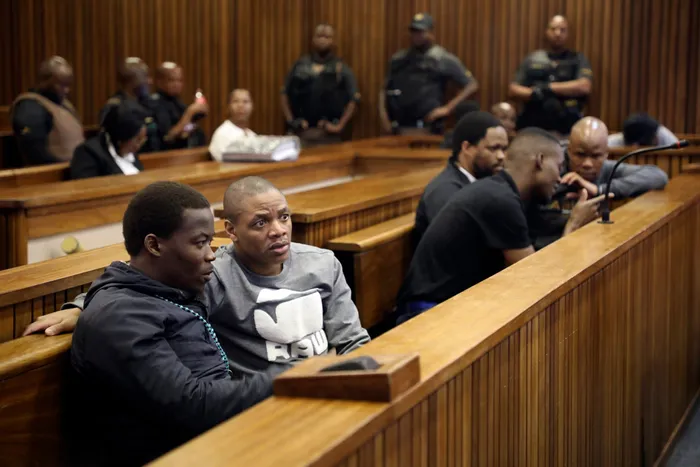‘Killing machine’ on Mncube linked to Meyiwa’s shooting

The five suspects accused of murdering Senzo Meyiwa are Muzikawukhulelwa Sibiya, Bongani Ntanzi, Mthobisi Mncube (in grey sweatshirt), Mthokoziseni Maphisa and Sifisokuhle Ntuli, during their appearance at the Gauteng High Court in Pretoria. | Oupa Mokoena African News Agency (ANA)
Johannesburg - The “killing machine” found in the possession of Mthobisi Prince Mncube during his arrest in 2015 has finally been linked to that which was used in the shooting of Senzo Meyiwa a year before.
Mncube, the third accused on trial in the Meyiwa murder, represented by advocate Charles Mnisi, was arrested in 2015 in relation to taxi violence in Cleveland, Joburg.
The link was made by police ballistics expert Lieutenant-Colonel Christian Mangena, a forensic analyst and crime scene reconstruction specialist whose evidence led to the conviction of Paralympian Oscar Pistorius in 2017. He has over 29 years of experience and over 5 000 examinations under his belt.
He told the court yesterday that the bullet that shot Meyiwa “perforated his body and hit the half-opened door behind him”.
Mangena said the bullet then ricocheted, and instead of penetrating the door, it landed on top of the kitchen counter. He said the shooter was most probably in front of the deceased, with the firearm in contact with his chest.
“The bullet perforated the body and hit the door behind him. The bullet trajectory was slightly downward, and the shooter was probably in front of the deceased, with the firearm in contact with the deceased’s chest.”
On confirming the firearm used to shoot Meyiwa, he said he had conducted eight tests on samples he received from evidence bags from the Cleveland matter on July 20, 2020.
Inside the bag, he said there were 16 rounds of 9mm cartridges as well as 10 cartridges of short calibre 9mm, as well as a 9mm parabellum model semi-automatic pistol with an obliterated serial number and one magazine.
“The bullet that was recovered from the crime scene was fired from this firearm (referring to the firearm discovered in Mncube’s possession),” Mangena said.
He said he was able to determine this after examining the projectile found on the kitchen counter at the crime scene and the test bullets that were fired from the gun found in Mncube’s possession.
The fragmented bullet found on the kitchen floor, however, couldn’t be examined as it was reportedly damaged upon impact with the tile floor.
The court was also given an opportunity to see the firearm, as Judge Ratha Mokgoatlheng indicated there were concerns that the firearm may have been switched given the time lapse since it was discovered.
Mokgoatlheng also quipped that he wanted to see the so-called “killing machine”, which was what Mncube had allegedly nicknamed the firearm.
The legal counsels of the five men, however, earlier informed the court that they were still in consultation with the families of the accused men in order to acquire the testimony of an impartial ballistic expert in addition to Mangena.
The trial continues today with the testimony of Mangena.
The Star
Related Topics: